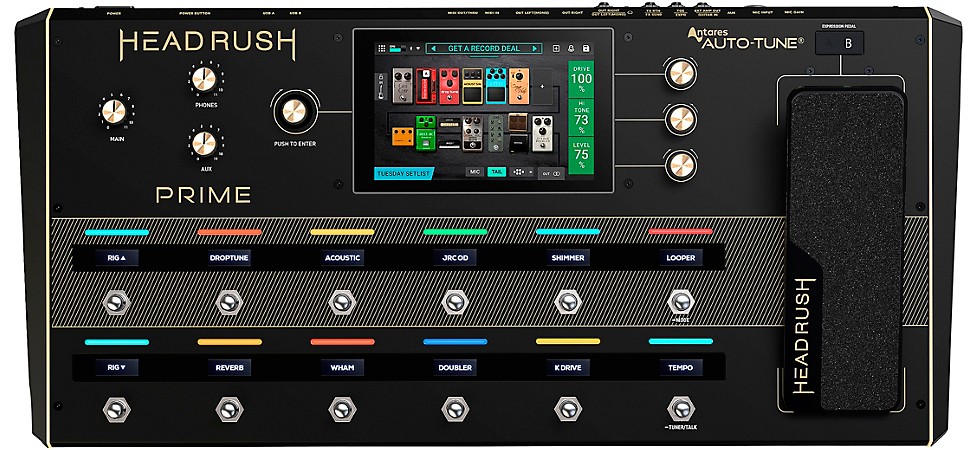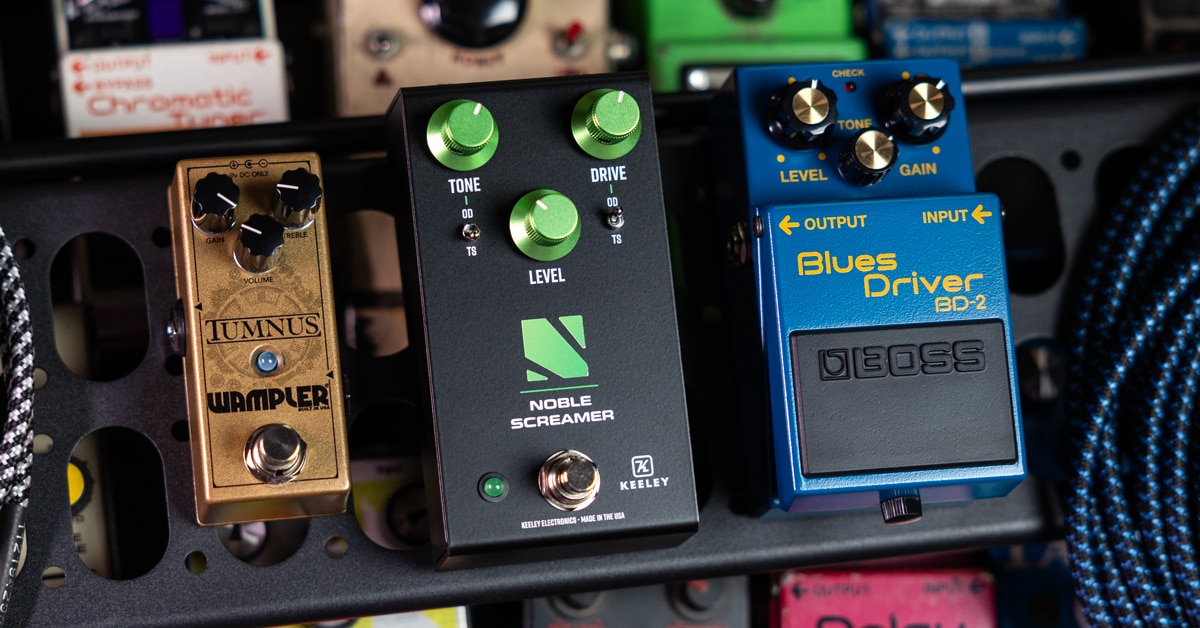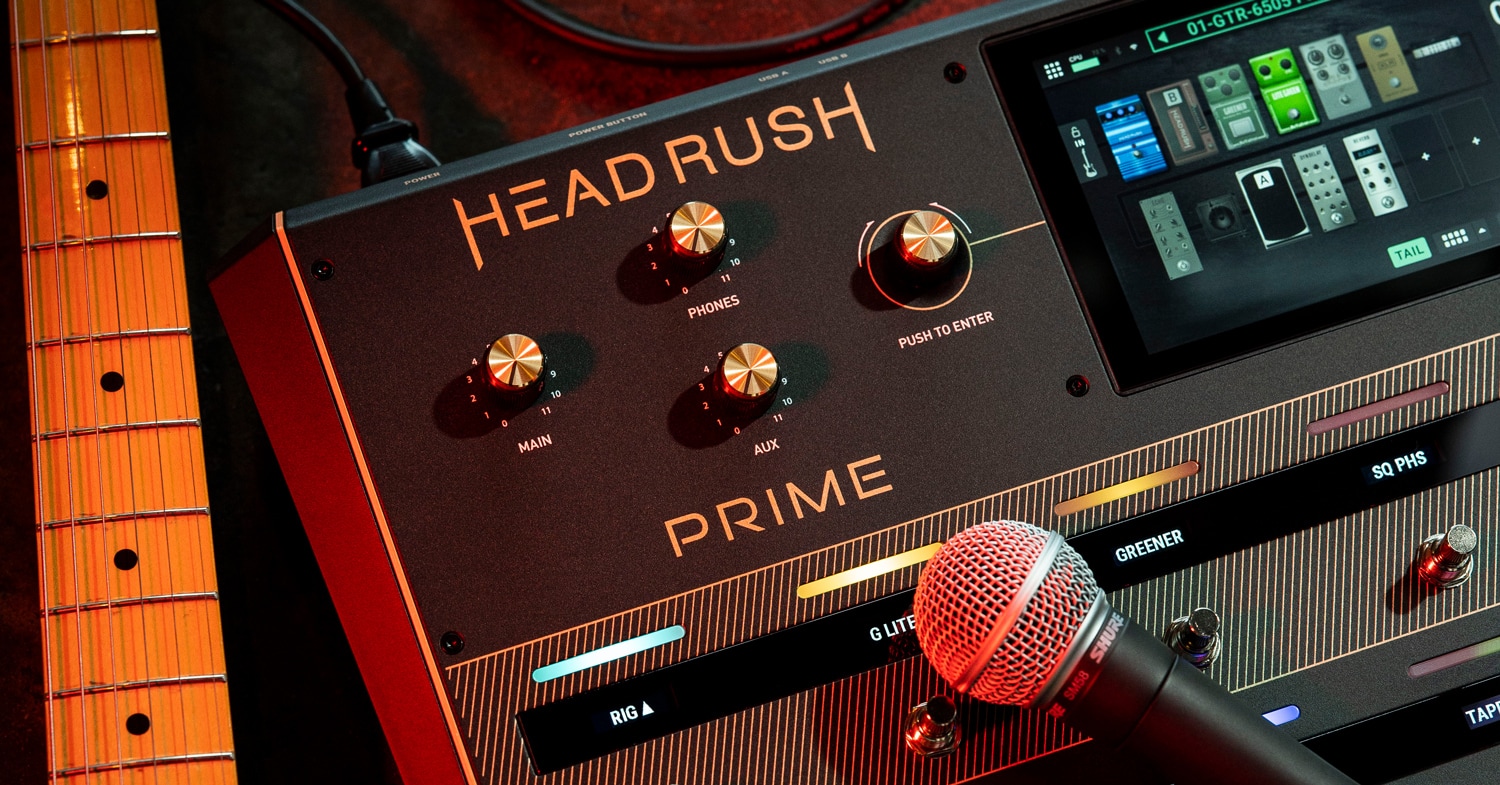The original HeadRush Pedalboard blew minds, populated stages and inspired guitarists to go places they had never gone before—creatively speaking—with its powerful DSP models and incredibly user-friendly controls. Suddenly, players could almost instantly build the massive guitar rigs of their dreams with the touch of a finger. No more seeking out the perfect delay or distortion pedal, or wondering how a part would sound with a different amp and/or speaker cabinet and then having to source truckloads of extra gear. Almost everything you’d want was in the box, and that box was also an elegant and road-tough travel rig. You could take it wherever it wasn’t feasible to lug an amp—such as a fly gig on a commercial airline—or rely on it if you were apprehensive about the quality of gear at backlined shows.
HeadRush Prime is the most powerful evolution of the platform designed and manufactured to date. It’s also no longer solely a guitar processor, as comprehensive vocal tools have been added to the Prime feature set. If you play guitar and sing, Prime offers a bounty of ways to sound awesome as both an instrumentalist and a vocalist—and all from a single pedalboard.
HeadRush Senior Product Manager Walter Skorupski has been at the company since the brand disrupted the industry (in a good way) with the original HeadRush Pedalboard in 2017. A graduate of Berklee College of Music, Skorupski has been gigging professionally as a guitarist and bassist for nearly 25 years—playing in everything from marching bands and rock groups to ska-punk, metal and jazz ensembles. He still loves to play, as well as bring the real-world performance knowledge that can only be acquired by actual gigging to the HeadRush design team.
Here, Skorupski details how the HeadRush development crew brought everyone’s experiences to bear for creating the feature-packed and sonically potent HeadRush Prime multi-effects processor. He also explains why HeadRush went to the trouble of including so many upscale vocal effects—including Antares Auto-Tune—in a guitar pedalboard. But, after reading this interview, you’ll get the idea that Skorupski doesn’t like passing up opportunities that can help musicians create sounds that inspire them. Supporting artists appears to also be an aspect of his private life, as he is always eager to help out his full-time musician friends by giving them a much-needed night off from a regular band gig. They can trust Skorupski will gleefully jump into the high-pressure mania of learning three sets of tunes in a week as a hired gun to give them a break.
How did your team approach the HeadRush Prime project?
Walter Skorupski: Since the debut of the HeadRush Pedalboard, our brand, product line and development team has significantly evolved—thanks to some very talented people joining us along the way. For the HeadRush Prime, we focused on usability first, in order to help musicians create and perform music freely, and without any disruptions to their process. Of course, we wanted it to look and sound incredible, too. HeadRush Prime leverages all the feedback we received from users of the previous Pedalboard, Gigboard and MX5 products. We combined that knowledge with some groundbreaking hardware and software technology we’ve been working on long term as a team, and we are incredibly proud of the results. The scope of features in a product like this is wide, but we knew from experience that sticking to the formula of combining real-world experience with next-generation technology would lead to a great product.
Was DSP upgraded for the Prime processor?
Yes. There’s significantly more horsepower in the Prime platform, and it allows players to do so much more compared to prior models. The DSP upgrade not only improved overall audio performance, it also allowed us to add new amp and effects models from our ReValver amp-modeling platform, increase the total amount of effects that can be loaded per preset, have separate effects chains for guitar and vocal—including Antares Auto-Tune—clone amps accurately and quickly, and more.
What features of the HeadRush Prime were served some “special sauce” to make them truly stand out?
The feel and response of the amp models and effects is what really jumps out, and makes me go, “Wow.” This is particularly exciting when it comes to our new Amp Cloner. There’s some ultrasecret special sauce in the way we clone the dynamics of an amp, which makes the response incredibly authentic and realistic. It’s especially noticeable when adjusting the volume knob on your guitar.
Are there any new models or effects Prime users should check out?
We’ve really expanded the tonal arsenal available to HeadRush Prime users by adding Antares Auto-Tune, a vocal-effects library, and a massive amount of amp and cabinet models and effects from our ReValver collection. The Peavey-branded amp and cabinet models are particularly exciting, as they were officially vetted and approved by Peavey’s engineering team. The authenticity of the Peavey models to the real-life equivalents is dead on.
What was the thinking behind including so many vocal effects in a guitar processor?
When you’re playing guitar or bass and singing when performing live, there are a lot of techniques you need to focus on while still entertaining a crowd. You need to sing in tune with great tone and confidence, while simultaneously playing your instrument well. It can very quickly get really hectic. With the addition of Antares Auto-Tune and our vocal-effects library, Prime gives performers real-time creative control of their vocal sound on stage. It’s so much easier to have everything in front of you on one pedalboard. You can even use the onboard Scenes feature to toggle between multiple guitar and vocal effects by stepping on a single footswitch.
Furthermore, the vocal effects library includes processing that goes beyond reverb, delay and de-essing, such as an automatic harmony effect that’s generated from the guitar chords you play, doubler and choir effects, a multi-band distortion optimized for vocals and a talkbox/vocoder effect that lets you use your guitar to control the pitch. The user can freely interchange guitar and vocal effects in a signal chain, so there’s a lot of room for creativity and experimentation.

It’s impressive that Prime can be used in a home studio, but not just for recording guitars.
The HeadRush Prime has a built-in 6-in/4-out USB audio interface for recording vocals and guitars without any additional hardware. The interface even lets you record wet and dry vocal tracks at the same time, so if you change your mind about the effects you used, but don’t want to rerecord a perfect take, you can simply reprocess the dry vocal track and change up the sound.
How does Amp Cloner work?
Amp Cloner is amazing. It’s way more than a simple IR capture. It’s an advanced, adaptive-learning system that trains itself to replicate the sound of an amp, preamp and distortion, overdrive or fuzz pedal with extreme accuracy. It may sound like the process is complicated, but Amp Cloner is incredibly easy to use. If you’re cloning a combo amp, or a head and speaker cabinet, all you need is a microphone and a few 1/4" cables. For cloning pedals and preamps, you don’t even need the mic. Prime’s screen walks you through the cloning process step-by-step, and even includes connection diagrams so you don’t have to go and find a manual.
After you’re hooked up, you set the signal level using an onscreen meter and hit Start. From there, it’s about a three-minute process of Prime playing tones through the amplifier and analyzing and creating the clone. Before you save the clone and add it to your rig, you can A/B the actual amp and the model, and refine the clone using EQ and/or our Sag and Chug controls. Another one of Amp Cloner’s great features is that you can delete the speaker—even if you cloned the amp with the speaker to make a preset. A convenient Cab On/Off button lets you match the amplifier part of your clone with a different speaker cabinet model or an IR of your choice.
We’ve been working on Amp Cloner for years, and we were incredibly excited to include it on the HeadRush Prime. We can’t wait to see what types of clones our users will upload to the HeadRush Cloud.
Speaking of uploading sounds, can you speak to the functionality of the Prime’s Wi-Fi and Bluetooth connectivity?
The built-in Bluetooth audio receiver offers a quick connection from your phone or tablet to the HeadRush Prime. This is very useful for referencing audio tracks during band practice—there’s no more wondering who swiped the AUX cord from the rehearsal space—as well as for practicing at home with lesson apps and playing along with backing tracks from YouTube.
The Wi-Fi connection lets the HeadRush Prime download and install new firmware updates directly from our server as soon as they’re released. Users can also link to their Dropbox accounts, which is especially helpful for transferring songs to use with the Prime’s practice tool feature. We are most proud of the HeadRush Cloud. When you log in to this free service, you’ll see exclusive presets and clones from artists that endorse HeadRush products, and you can search, filter and demo a huge library of files from other users, as well. It has been very exciting to see new HeadRush Prime users upload content to the HeadRush Cloud since Prime started shipping. We can’t wait to see it grow even more.
There are a ton of signal-flow routing options available on the HeadRush Prime.
The HeadRush Prime’s rear panel is packed with I/O—which makes it simple to drop it into your current setup. The audio inputs include 1/4" instrument, combo XLR/1/4" (with switchable 48V phantom power), 1/8" stereo AUX and 1/4" stereo effects loop. Outputs include a stereo pair of XLR (with switchable ground lift), a pair of 1/4" balanced outputs (switchable between line or amp level) and a 1/8" headphone output.
The stereo 1/4" effects loop can be used for incorporating external effects pedals anywhere you’d like within your rig. You can also use it to route HeadRush Prime effects to an amplifier’s effects loop for maintaining pristine reverb and modulation tones, while simultaneously hitting the front end of an amp for traditional wah and overdrive sounds. This way, the Prime’s effects are working together with your amp to give you the best possible tone.
Overall, you have five different signal sources you can route to the outputs in mono or stereo, depending upon how you configure the effects within a preset. Guitar Out is your main signal with effects applied, and there’s a second Guitar Out for presets that have two guitars configured at the same time. Alt Guitar Out can be configured to come from anywhere within the rig. A common use case for this output is sending all the effects in your preset—but without amp modeling—to connect to an onstage amplifier using the 1/4" outputs. Then, you can send your complete preset including amp modeling to the house sound system via the XLR outputs. Now you can hear your real amp onstage, the audience hears the modeled preset and you save the hassle of having to mic the amp for the PA.
Vocals Out is your main vocal signal with effects. Mic Dry Out is the dry, unprocessed sound of the vocal, which can be used for sending a natural sound to IEMs, devoid of reverb and delay effects that can make it challenging to sing in pitch and in time. Another very common use is when you have a very complex guitar rig, but no need for vocal effects. In this case, you can still use the dry output to sing simple backup vocals or talk to the crowd, or even speak while streaming via Twitch or YouTube.
Each of these signal sources can be sent to the stereo XLR outs, stereo 1/4" outs or headphones output simultaneously or separately. For example, you can send your vocal output to the XLR outputs, your guitar signal to the 1/4" outputs, and then send your dry vocal and guitar sounds to the headphones output for monitoring.
That’s a lot of information, and it sounds complicated, it’s really easy to set up. Just jump into the Global Settings page, and you have a list of the signal sources, as well as output buttons to tap for each of the sources.
What about some of the non-audio I/O?
There are 1/4" connections for an additional external expression pedal with a toe switch—like the HeadRush Expression Pedal—as well as a 1/4" connection that can be routed to the footswitch input of a traditional amplifier to remotely change amp channels or toggle its effects from the HeadRush Prime.
You can also do a lot with the Prime’s MIDI In and Out. Incoming MIDI Program Change messages can change specific rig presets, and outgoing MIDI Program Change messages be sent to other hardware when a rig loads on the HeadRush Prime. Incoming MIDI Control Change messages can turn blocks on and off, as well as simulate footswitch presses. Then, incoming MIDI Clock messages can sync time-based effects or the looper tempo to an external MIDI device. MIDI Note messages can be used to control the vocal harmonizer or the vocoder/talk box effects.
The Prime offers two USB ports—a USB-A and a USB-B. The USB-A port lets you connect a storage device like a thumb drive to transfer files, but it also allows you to connect a class-compliant MIDI controller—such as a USB-MIDI keyboard that doesn’t require drivers or external power—to send MIDI to the HeadRush Prime. The USB-B port is for connecting directly to a Mac/PC, and can be used for recording direct, file transfers and firmware updates. In short, the HeadRush Prime should have all the I/O you need to assimilate into your current setup, and likely it will provide new options for you to expand your possibilities even further.

Are there any additional features guitarists will appreciate?
The onboard practice tool is very easy to use, and it’s extremely helpful when you need to learn a bunch of new songs for an upcoming gig or rehearsal. You simply import your songs to the HeadRush Prime via a linked Dropbox account or USB connection. Then, you can set loop points within a song to rehearse tricky sections, or you can vary the speed of a song without changing the pitch. Whether you’re learning songs to audition for a band or brushing up on old tunes you haven’t played in a while, this feature can be a real gig saver.
Do you have any favorite sounds you think users should check out?
I absolutely recommend users check out our factory presets. Our friends at Choptones created 50 presets that provide a great overview of the variety of sounds you can get out of HeadRush Prime’s library of amp models, cab models and effects. It’s very tough to pick my own favorite, but lately I have been spending a lot of time with our new Party Verb effect—which is our exclusive take on a particle-style reverb. It’s incredibly rich sounding, and you can create these wide, gorgeous ambient textures by just playing chords. I’m pretty sure playing with Party Verb can be a form of meditation.










